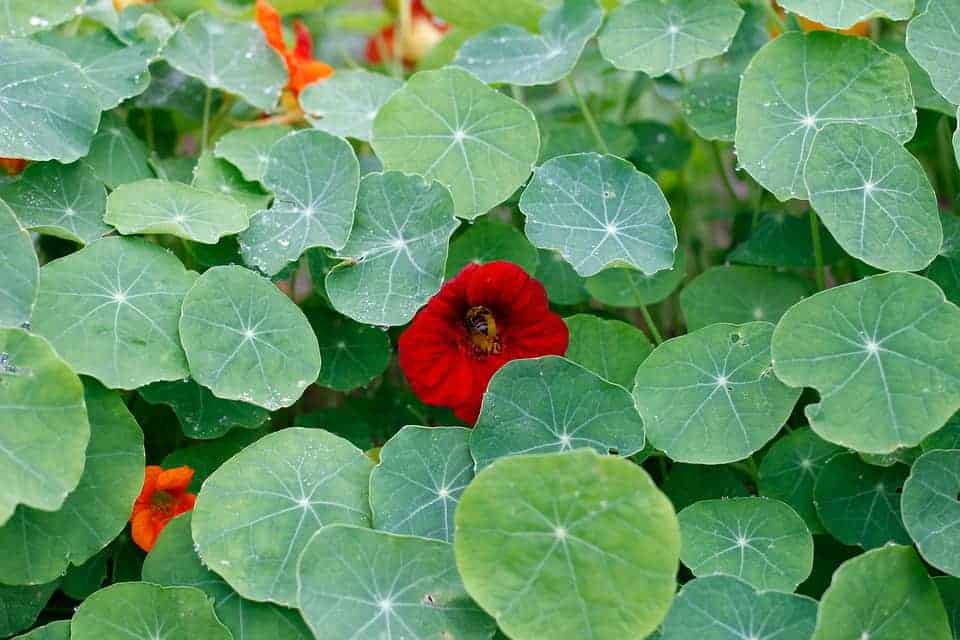Nasturtiums are a highly underrated flower. They are ornamental, yet the flowers, leaves, and young seed pods are all edible and have a slightly peppery mustard-type kick.
However, you may have also heard that nasturtiums make a great companion plant and can keep bugs away. There are some misconceptions about if and how they can repel insects, but nasturtiums are still an effective companion plant in the garden.
On this page:
Do Nasturtiums Keep Bugs Away?
Nasturtiums can repel cabbage loopers (but not cabbage worms), squash bugs, and other beetles like cucumber beetles through pest confusion.
However, pests are not actually repelled by nasturtiums. Instead, they fly away because they get confused. There has been research [PDF] on this which confirms this is how pest repulsion really works.
Flying insects are drawn to their host plant to eat or lay eggs, but they are not very coordinated when flying. So when they fly up and move to another leaf, if that leaf is of a non-host plant (like a nasturtium), they will immediately realize they are not on the right plant. Then they will fly up and back down onto another leaf, which might be another nasturtium leaf.
For instance, if a cucumber beetle might be right next to a cucumber plant, but if half the time it’s clumsily landing onto a nasturtium, it will get confused and buzz off. This is how nasturtiums repel pests.
Do Nasturtiums Attract or Repel Aphids?
Aphids are drawn to nasturtiums, and especially search for new growth and tender stems and petioles.
There are many different kinds of aphids which can attack nasturtiums, but they are particularly attractive to melon aphids, peach aphids, and black bean aphids. The names of these aphids do not refer to their main host plants, and all three can be found on a variety of vegetables in the garden.
The fact that aphids readily go after nasturtiums makes nasturtiums a good trap crop if you have aphid problems.
What Are Trap Crops?
Trap crops are plants which are grown specifically to attract pests and draw them away from the plants you want to protect. The trap crops are essentially sacrificed to the pests.
Trap crops can be varieties of the same vegetable that pests prefer, or can be different vegetables or flowers which are equally or more attractive to a pest you want to keep away from the plants you want to protect.
The important thing to note is that trap cropping requires gardeners to go out and remove the pests. For example, if you are planting a nasturtium border away from your tomatoes to protect them from aphids, you will still need to check your nasturtiums and kill or wash away the aphids, otherwise, you are just breeding aphids and they will end up finding your tomatoes after.
What Other Bugs Eat Nasturtiums?
Nasturtiums are also targeted by cabbage worms, spider mites, whiteflies, and leafhoppers.
The most destructive pest that likes nasturtiums are cabbage worms, which are the larvae of small white butterflies.
These small white butterflies love Brassica family plants like broccoli, kale, cabbage, Brussels sprouts, kohlrabi, collards, radishes, and mustard and are identified by being white with at least one or two noticeable dark dots on their wings. The butterflies do not eat the plants; instead, they lay tiny eggs, usually on the underside of leaves, and a green cabbage worm hatches out after a few days. One or two cabbage worms can decimate large leaves.

Do Nasturtiums Make Good Companion Plants?
Nasturtiums make excellent companion plants, especially for pest confusion, and to a lesser extent for trap cropping.
In addition, they are vining flowers, very ornamental, and also have the benefit of having edible leaves, petals, and even the young seed pods are edible. Nasturtiums are great to grow in their own right.
How to Use Nasturtiums as Companion Plants
Nasturtiums work best for aphids (trap cropping), squash bugs and cucumber beetles (pest confusion/repelling).
For aphids, plant nasturtiums as a border away from your plants. Aphids are very clumsy insects and minor infestations can be resolved with just spraying them off your plants, so when they enter your garden, they will find your nasturtiums first and can be dealt with before they infest your garden beds.
Nasturtiums are excellent for repelling squash bugs and cucumber beetles because nasturtiums are vining plants like squash, melons, and cucumbers. In this case, interplant your nasturtiums with your squash plants and cucumbers, either between plants or in alternating rows.
For example, if you’re growing cucumbers or small squash and melons on a trellis, also train your nasturtiums to climb up the trellis between them, which will confuse beetle pests. For bush squash or vining squash growing on the ground, plant some nasturtiums in the same bed and them sprawl across the ground together.
